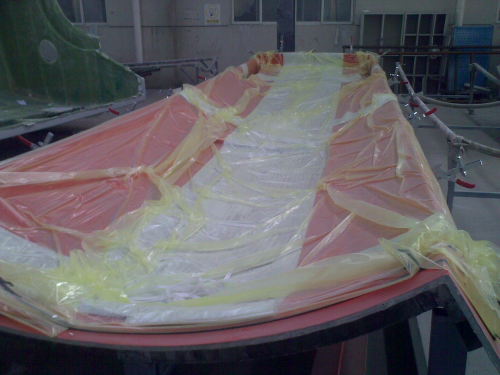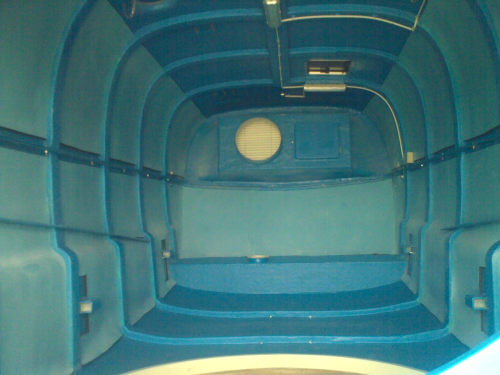

The first thought that comes to mind when talking about vacuum infusion and wind energy is blade manufacturing.
The main manufacturing process for rotor blades at the moment is vacuum infusion. In vacuum infusion high fibre volumes are combined with low void contents, resulting in high quality composite products that can withstand the dynamic wind loads occurring during the operation of a wind turbine.
But there are also other parts of the wind turbine that are usually made with composite materials – the spinners and the nacelles. These parts have less demanding mechanical properties but are nevertheless products that need a certain quality level to last their intended life span.
Nacelle production
Traditionally, the open mould manufacturing processes of hand lay-up and spray-up have been very popular for spinner and nacelle production. The relative fast cycle times and low costs related to the open mould processes were leading factors in choosing between open or closed mould manufacturing. Today, however, due to requests for consistent quality and better controlled tolerances, a shift to closed mould manufacturing has been occurring and is still ongoing. This requires a different approach to engineering and evaluating materials that are necessary in the production of these parts.
The shift to closed mould manufacturing is being driven by environmental and health regulations as well.
More and more nacelle manufacturers are changing, or have already changed, their production process from hand lay-up/spray-up to vacuum infusion or even light resin transfer moulding (Light RTM). Vacuum infusion however seems to be the more favorable production process considering the large surface areas of the nacelle.
One important advantage that vacuum infusion has over Light RTM is that during the actual wetting out of the dry stack of material, possible mishaps can be easily seen and corrected during production. Looking at the size of the nacelles this will lead to a considerable reduction of scrap.
Another advantage is that a better fibre to resin ratio can be realised in infusion, which will obviously give a better quality of the produced parts.
In the last couple of years this shift from open mould to vacuum infusion has been picking up speed. In particular, the nacelle manufacturers in countries with a strong wind industry, such as Denmark, Spain and Germany, have showed a gradual increase in the use of the vacuum infusion process. In the exploding wind industry market of China the major players are also adopting vacuum infusion as the preferred process for the manufacturing of nacelle covers. This is either being introduced by the first Western companies that have started in China, or driven by the vision that infusion is the more durable process in the long run.
Making the transition
Lantor Composites, based in the Netherlands, is working closely with companies that either are in the middle of the transition from open mould to vacuum infusion, or have already made the shift, to help them benefit fully from the advantages of the infusion process. When introducing the vacuum infusion process one is faced with changes in mechanical properties, the use of different materials and, of course, process specific changes. These changes make it important to review lamination schedule of, for example, the nacelle, with which Lantor Composites is able to offer support.
Besides this service, Lantor Composites also offers a product that is engineered specifically for vacuum infusion: Lantor Soric Flexible Core. This product has proved to be an excellent supportive product in the process transition. Lantor Soric Flexible Core is both an interlaminar flow medium and a core that after wetting out will ‘change’ into a strong core material embedded in the laminate.
The introduction of Lantor Soric as an interlaminar flow core will reduce the effects of thickness loss due to the applied vacuum and more important it will also reduce the use of consumable flow media drastically. Lantor Soric will help manufacturers realise a stronger, lighter and more sophisticated laminate that the infusion process is meant to provide. During the actual infusion the interlaminar flow properties of Lantor Soric can help control the process more and therefore realise a more consistent manufacturing process and end quality of the products. As a result of these properties of Lantor Soric Flexible Core, customers have been able to make the transition from open to closed mould and end up with a more economical viable and sustainable process.
|
In infused laminates, the use of Soric Flexible Core helps to improve overall product performance, and process efficiency. Its use as a thin core (XF, SF, LRC grades) and print barrier (TF grade), as well as an interlaminar infusion medium, achieves substantial time savings and a significant reduction in disposables. Soric Flexible Core is a polyester nonwoven material with a compression-resistant hexagonal (XF, SF, LRC grade) or random dot-printed (TF grade) cell structure. These pressure resistant cells, which are separated by channels, contain synthetic microspheres. The cells do not absorb resin and therefore limit the total resin uptake. Since these cells are pressure-resistant, they create thickness in the laminate even when pressure is applied by vacuum: thickness/stiffness without an extra weight penalty. The channels facilitate resin flow and form a pattern of cured resin with good mechanical properties and excellent bonding to the outer skins. Because of these properties and characteristics, the core can be used as:
|






